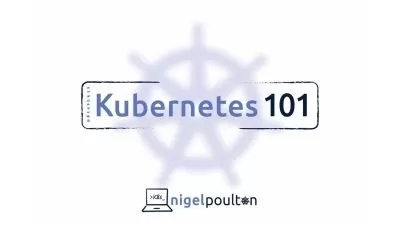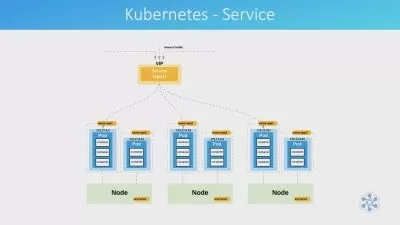Google Kubernetes Engine (GKE) - A Complete Practical Guide
K8s Point - Training House for Kubernetes
12:13:19
Description
Google Cloud Platform, Google GKE, Kubernetes in GCP, Ingress, Gateway, Cloud SQL Auth Proxy, FUSE, Scaling,Loadbalacing
What You'll Learn?
- You will know everything that you need to know about Google Kubernetes Engine (GKE)
- Course full of Demos and practical implementation of GKE
- This course covers all the aspects of GKE including newer features like Gateway, FUSE and many more
- Anthos Service Mesh / Istio Service Mesh in GKE
- Understand how to attach a Persistent Disk or Google File Store to a pod using Volume
- Perform Cloud Storage Bucket integration ( using FUSE) with GKE Pods
- Various aspects of connecting to Cloud SQL
- Implement connecting to SQL with Cloud SQL Auth Proxy as both sidecar and service implementation
- Scaling options in GKE including Horizontal Pod Autoscaling, Vertical Pod Autoscaling, Nodepool Scaling, Cluster Autoscalling
- RBAC Implementation in GKE with example
- All the aspects of Security in a GKE cluster
- Kubernetes Ingress implemetation
- Kubernetes Gateway implementation
- Securing your application with Certificates
- Public GKE Cluster and Private GKE Cluster
- Autopilot GKE Cluster and Standard GKE Cluster
- Release management in GKE with Kubernetes upgrade process
- Real world implementation of GKE
- Workload Identity in GCP
Who is this for?
What You Need to Know?
More details
DescriptionA complete course on GKE which covers all the aspects of Google Kubernetes Engine (GKE) with demos and practical implementation.
Teaches basic of Kubernetes along with GKEÂ implementation. This course covers real world implementation of GKE in a corporate environment. Learn how to use GKE in your work
Covers topic:
Different type of GKE cluster
Public Cluster, Private Cluster, Standard GKE Cluster, Autopilot GKE Cluster, Regional Cluster, Zonal Cluster
Implementing GKE topics with sample app for each understanding
Anthos Service Mesh / Istio Service Mesh in GKE
Kubernetes Ingress implementation in GKE
Kubernetes Gateway implementation in GKE
Attach a Persistent Disk to a pod as Volume
Attach a Filestore to a pod as Volume
Attach a GCP Bucket ( Cloud Storage) to a pod as Volume using FUSE
Different type of Services in Kubernetes and loadbalancer implementation
RBACÂ implementation in GKE
Kubernetes cluster upgrade process
Release management
Cloud SQLÂ connection option ( secure and insecure)Â from GKE
Workload Identity
Cloud SQLÂ Auth Proxy
Sidecar container implementation
Horizontal Pod Autoscaling
Vertical Pod Autoscaling
GKE cluster autoscaling
Autopilot Cluster with merits and limitations
Security Posture Management
Workload Scanning in GKE
Service Account best practice in GCP and Kubernetes
RBACÂ with roles and responsibility with demo
Release channel in GKE
Exposing application with loadbalancer
Probes in Kubernetes
Healthcheck with Loadbalancer
Who this course is for:
- Anyone looking to learn Kubernetes and Google Kubernetes Engine from basic
- Google Cloud implementation of Kubernetes
A complete course on GKE which covers all the aspects of Google Kubernetes Engine (GKE) with demos and practical implementation.
Teaches basic of Kubernetes along with GKEÂ implementation. This course covers real world implementation of GKE in a corporate environment. Learn how to use GKE in your work
Covers topic:
Different type of GKE cluster
Public Cluster, Private Cluster, Standard GKE Cluster, Autopilot GKE Cluster, Regional Cluster, Zonal Cluster
Implementing GKE topics with sample app for each understanding
Anthos Service Mesh / Istio Service Mesh in GKE
Kubernetes Ingress implementation in GKE
Kubernetes Gateway implementation in GKE
Attach a Persistent Disk to a pod as Volume
Attach a Filestore to a pod as Volume
Attach a GCP Bucket ( Cloud Storage) to a pod as Volume using FUSE
Different type of Services in Kubernetes and loadbalancer implementation
RBACÂ implementation in GKE
Kubernetes cluster upgrade process
Release management
Cloud SQLÂ connection option ( secure and insecure)Â from GKE
Workload Identity
Cloud SQLÂ Auth Proxy
Sidecar container implementation
Horizontal Pod Autoscaling
Vertical Pod Autoscaling
GKE cluster autoscaling
Autopilot Cluster with merits and limitations
Security Posture Management
Workload Scanning in GKE
Service Account best practice in GCP and Kubernetes
RBACÂ with roles and responsibility with demo
Release channel in GKE
Exposing application with loadbalancer
Probes in Kubernetes
Healthcheck with Loadbalancer
Who this course is for:
- Anyone looking to learn Kubernetes and Google Kubernetes Engine from basic
- Google Cloud implementation of Kubernetes
User Reviews
Rating
K8s Point - Training House for Kubernetes
Instructor's Courses
Udemy
View courses Udemy- language english
- Training sessions 112
- duration 12:13:19
- Release Date 2024/07/23
















